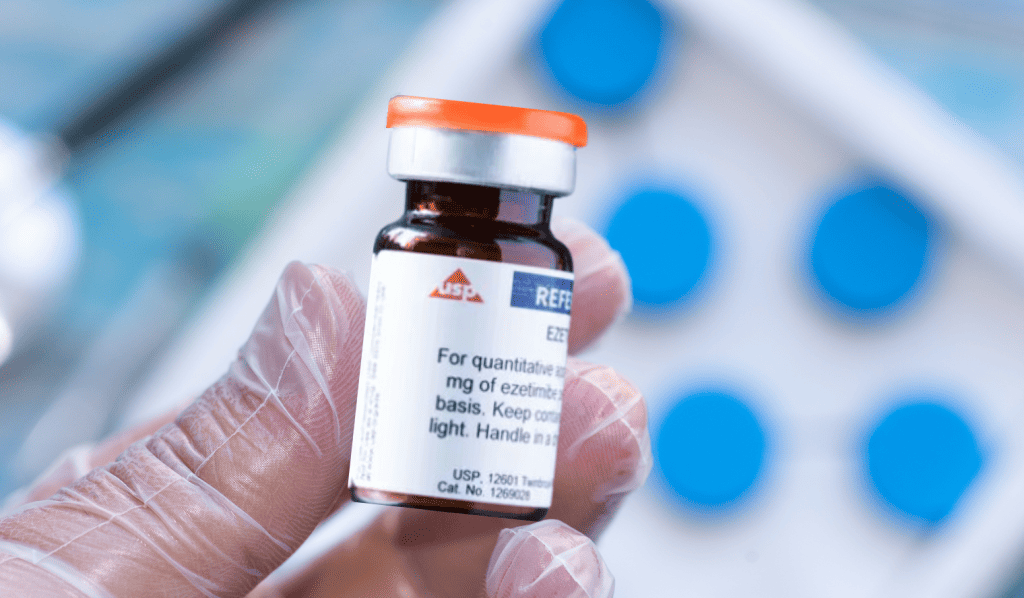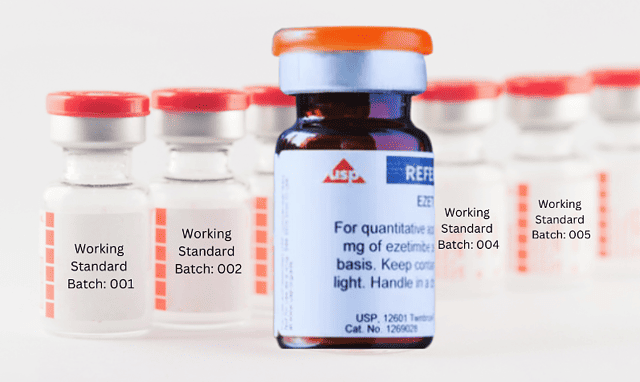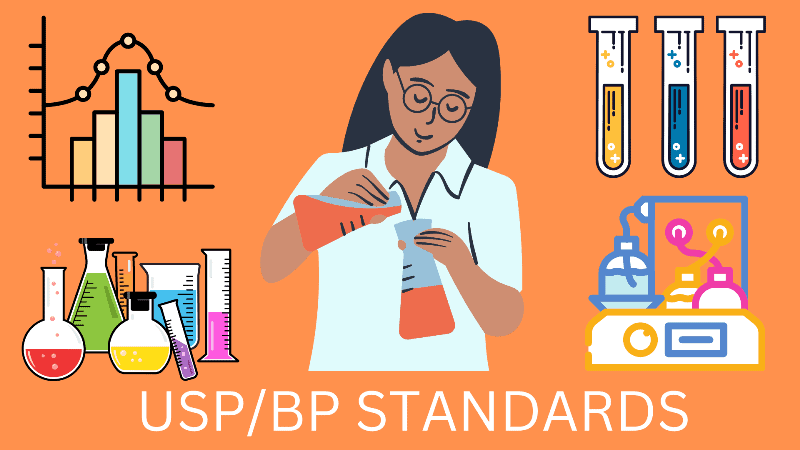
What is meant by reference standard in Pharmaceuticals?
- Kazi
- Last modified: March 13, 2025
The reference standard is the cornerstone of analytical methods used to assess pharmaceutical products’ quality, safety, and potency during the development phase and the product’s market life.
Consequently, it is essential that you have unique reference standards for each medicinal product that you produce and you test your products against those standards consistently. As a result, your products are readily acceptable worldwide.
A reference standard is a specific batch of a substance of known composition and purity to which responses of samples of unknown composition or purity are compared to determine the concentration or purity of that unknown composition.
Table of Contents
What are the types of reference standards?
Pharmaceutical laboratories use two types of reference standards for their testing purpose.
i. Primary reference standard:
A primary reference standard (sometimes also called master standard) is a substance that an extensive set of analytic tests has shown to be authentic material that should be of high purity.
Pharmacopeias and regulatory agencies recognize primary standards as the official industry standards for particular tests.
Primary standards can be:
– Obtained from an officially recognized source
– Prepared by independent synthesis
– Obtained from existing production material of high purity if there is no other external primary standard available Or
– Prepared by further purification of existing production material
ii. Secondary reference standard:
Secondary reference standards (sometimes also referred to as working standards) are substances of established quality and purity, usually prepared in-house.
These standards can only be used if they are standardized against primary standards using definitive methods published in pharmacopeias and national and international standards.
As a rule of thumb, primary standards should be used in testing wherever economically possible.
iii. Development reference standards:
These are unique reference standards used to support product development if a primary reference standard has yet to be previously established for the material.
These can be placed in the reference standard program upon the request of the developing organization.
250 SOPs, 197 GMP Manuals, 64 Templates, 30 Training modules, 167 Forms. Additional documents are included each month. All written and updated by GMP experts. Check out sample previews. Access to exclusive content for an affordable fee.
Who can provide reference standards?
As indicated under definitions, primary reference standards are substances manufactured and tested to comply with a certified source.
The certified sources from which these standards can be obtained are British Pharmacopeia (BP) and United States Pharmacopeia.
Chemical and biological primary standards can be purchased by contacting either of the following authorities:
– BP, EP, USP
– ANSI
– College of American Pathologists (CAP) for clinical standards
– US National Bureau of Standards (NBS)
You may have to use analytical reagents as primary reference under special circumstances, especially if the substances are unavailable through the above sources.
Where this is the case, a reputable supplier should be used, and a certificate of analysis for the substance should be obtained.
Secondary standards are prepared from the primary standards using validated methods when necessary, typically in-house facilities.
After the preparation, secondary references are tested for potency, labeled, dated, stored, handled, and used in testing so as not to prejudice quality.
The secondary reference standards can be prepared by sampling the purchased raw materials’ active substance, testing these against a primary reference standard to establish its purity, and then using these in routine analysis.
These secondary standards are originally used for manufacturing products, received with the manufacturer’s certificate of analysis, and tested by the laboratory on arrival to conform to specifications.
A register should be used to record the source, identity, and any other available information concerning the preparation and characterization of these substances, as well as the date put into service and the date taken out of service.
How to procure primary reference standards?
You can arrange an order of primary reference standards simply by contacting them with the details:
– Standards needed
– The Pharmacopoeia to buy from (i.e., USP reference standard)
– The Pharmacopoeia catalog number
– The number of bottles needed (include weight per bottle, e.g., 2 x 25mg bottles)
– The urgency requirement
The following should also be sent to the Pharmacopoeia via registered mail:
– Copy of Purchase Order Number
– Copy of Licence to Import
– Payment details where applicable
If the pharmacopoeias asked for a statement of use for the reference standards being ordered, it would be appropriate to include in the letter a statement for appropriate use.
Note: Follow local regulatory guidelines for importing reference substances.
250 SOPs, 197 GMP Manuals, 64 Templates, 30 Training modules, 167 Forms. Additional documents are included each month. All written and updated by GMP experts. Check out sample previews. Access to exclusive content for an affordable fee.
How to prepare secondary reference standard in-house?
You can prepare secondary standards from the raw materials (active ingredients) you purchase from the manufacturer.
The secondary standards are sampled in the warehouse at the time of arrival and tested in the laboratory against the corresponding primary reference standard or an established secondary reference standard to determine its assay (concentration) and purity.
You should collect the manufacturer’s certificate of analysis of the sampled raw material. Check the re-test / expiry date of the raw material. This will enable a sample of longer shelf life.
If the new raw material sample is tested against an established secondary reference standard, please don’t use the same batch number for both.
When you request a raw material (API) sample for secondary standards, please make sure the batch requested won’t be used to manufacture future batches of finished products.
In some exceptional circumstances, there may be no raw material batch in the warehouse other than the one used by production to make finished product batches.
If the raw material is available as an analytical grade pure substance in chemical catalogs, purchase some and qualify it against a primary reference standard to convert it into a secondary reference standard.
When the material is not available as an analytical grade pure substance, then the secondary reference standard used to test the finished batch is allowed to be the same batch number as the raw material in the batch as long as the secondary reference standard has been qualified against a primary standard before use.
What is the purpose of reference standards in laboratory?
Reference standards have versatile use in pharmaceutical laboratories to determine the purity and concentration of unknown substances.
Primary standards may be utilized for the following purposes:
– Potency Standards – to support major component assays
– Impurity Standards – to support quantitation of minor components.
– Identification Standards – to serve as identification comparators
– Standards for Chemical Intermediates – assays
– Special Use Standards – to provide standards for special uses
Secondary standards are typically characterized against an appropriate Primary reference standard and are distributed for routine use.
Generally, only one working standard will be approved for a specific use at any time.
The categories of secondary standards are as follows:
– Potency Standards
– Impurity Standards
– Resolution Standards
– Identification Standards
– Chemical Intermediate Standards
– Special Use Standards
250 SOPs, 197 GMP Manuals, 64 Templates, 30 Training modules, 167 Forms. Additional documents are included each month. All written and updated by GMP experts. Check out sample previews. Access to exclusive content for an affordable fee.
How to use standards in routine laboratory analysis?
a) Before using a reference standard, the analysts should confirm that the standard is within the expiry/ re-test period by referring to the “reference standard log book,” the appropriate “summary sheet” for the reference standard, or the pharmacopeia catalogs.
b) The authorized laboratory staff responsible for reference standard updates new information on the “reference standard log book.” Also, we should perform a monthly check of expiry details against the pharmacopeia catalogs.
c) Laboratory analysts, using the reference standard, must consider using the vials received earliest first and then follow in order of receipt.
Where there is more than one vial of the same reference standard available, only one vial should be allowed to be used at any given time in numerical order unless unusual circumstances arise.
d) When the reference standard is first opened, an “opened date” must be written on the vial’s label. This date must be reported to authorized staff responsible for reference standard maintenance, who will update this information on the appropriate “reference standard log book and summary sheet”.
e) Reference standard must be equilibrated to room temperature before use unless other considerations apply to the substance.
f) When a reference standard requires pre-treatment before use, ensure only the portion to be used is pre-treated and not the whole contents of the bottle.
g) When opening a Pharmacopoeial primary reference standard vial, store by covering the lid with para film wrap and place in a container that contains a little desiccant, then store as all other vials.
h) finished or expired reference standard vials must be returned to the authorized laboratory staff for maintenance. The date the vial is discarded should be entered into the “reference standard log book and summary sheet”.
How to determine expiry and retest dates for reference standards?
Over time, the terminology describing the “Use by” date for reference standard has become more defined.
The term “Expiry” date was used initially, and now we are finding the term “Retest” date is also used.
“Expiry” date now signifies the absolute date beyond which the reference standard may no longer be used, whereas the “retest” date is the date beyond which the reference standard cannot be used unless it has been confirmed by re-testing to be suitable for continued use and at which point this retest date can be extended further.
Both “expiry” date and “retest” dates are taken to mean the date beyond which the reference standard can no longer be used unless it has been confirmed by re-testing to be suitable for continued use.
When determining the expiry date and re-test date, the following rules are also applied:
i. Primary reference standards are given a maximum shelf life of 18 months after opening.
When the expiration date published by the pharmacopeias is within this period, the pharmacopeial expiration date will take precedence.
Once opened, primary standards purchased for identity use can be used until the expiration date is published unless special consideration requirements are applicable for the substance.
ii. Secondary reference standards should be retested inhouse yearly against primary standards.
The retest date for these may be set at a maximum of 1 year from this testing date. Still, the reference standards may only be used up to the expiry/ re-test date on their certificate of analysis or the documented stability profile time frame for the substance, where the manufacturer does not publish expiry or re-test details or would indicate the substance can be used further.
250 SOPs, 197 GMP Manuals, 64 Templates, 30 Training modules, 167 Forms. Additional documents are included each month. All written and updated by GMP experts. Check out sample previews. Access to exclusive content for an affordable fee.
Information in reference standard log book
You should divide the reference standards logbook into several sections identifying the separate types of standards in use and relevant information.
– Notes section – This section provides the space to point out relevant general information regarding the spreadsheet, including notes on how to make changes and find your way around it.
– Primary standards – This section is for information on the date purchased, pharmacopeia catalog reference, name of the active ingredient, license to import, number of vials, expiry date, purchase order, etc.
– Secondary standards – This section is for information such as raw material batch number, concentration, purity, certificate of analysis, expiry / re-test date, number of vials, current vial in use, etc.
– Primary reference standards expiry check – This section provides communication of expiry dating checked by the authorized Laboratory staff responsible for reference standard maintenance checked against the pharmacopoeial catalog.
Difference between laboratory reagents and reference standards?
Reagents are materials used in the laboratory that are not necessarily extremely pure but can be used if purity is determined.
In that regard, secondary standards are reagents until their purities are determined.
A primary reference standard is used to compare unknown amounts of reagent to itself because the precise concentration of primary standards is known.
Reagents made up in the laboratory should be prepared following standard procedures.
As applicable, labeling should indicate the concentration, standardization factor, shelf life, and storage conditions.
The label should be dated, signed, or initialed by the person preparing the reagent.
Where relevant, a date for re-standardization should be recorded.
In some instances, it may be necessary to carry out tests to confirm that the reagent Is suitable for the purpose for which it is to be used. A record of these tests should be maintained.
Where appropriate, I would like to point out that purchased reagent solutions should be dated when you get them.
The accuracy and precision of test results and test methods are dependent on the reliability, authenticity, and control over reference standards, reagents, and stock solutions.
Similarly, the retrospective testing of materials and products depends on the protection and storage of retention samples.
How to manage laboratory reference standards?
Laboratory standards should be properly controlled under quality control rules not to prejudice their quality.
Control over standards should encompass the following:
– A SOP for standards management, including standard selection, standardization, change, and control
– A reference standards register and inventory system
– A designated custodian of all standards
– Appropriate labeling of standards, including:
i. Date of introduction and expiry
ii. Complete description (name, source, and lot number)
iii. Strength, activity, and confidence interval
iv. Storage conditions
– Protection from heat, light, humidity, irradiation, and vibration
– Storage in a secure and monitored area
– The standard lot number must always appear in the testing record.
– Reference Standards shall be packaged in appropriate container closure systems
– Comprehensive analytical documentation at the source of the standard should be available for all standards used.
250 SOPs, 197 GMP Manuals, 64 Templates, 30 Training modules, 167 Forms. Additional documents are included each month. All written and updated by GMP experts. Check out sample previews. Access to exclusive content for an affordable fee.
Conclusion
To sum up, reference standards are essential for ensuring pharmaceuticals’ efficacy, safety, and quality throughout the development process and after we release the products in the market.
We have emphasized the need to acquire primary standards from verified sources, such as pharmacopeias’ since these are used as the benchmark to prepare working standards.
The article guides you on acquiring primary standards, preparing subsidiary standards, determining when to retest or expire, and keeping thorough record books.
It highlights the necessity of thorough record-keeping while creating internal secondary reference standards and outlines the data that employees must be entered into the logbook.
The document further clarifies the shelf-life considerations for primary reference standards, allowing a maximum shelf life of 18 months following opening and, when appropriate, giving precedence to pharmacopeial expiry dates.
It also clarifies the primary distinction between laboratory reagents and standards, highlighting the former’s function as verified quality and high-purity materials that serve as recognized industry test standards.
Finally, the article emphasizes the importance of following local regulatory requirements while importing reference materials and keeping thorough logs in the logbook.
Maintaining pharmaceutical quality standards and regulatory compliance heavily depends on the appropriate management and application of reference standards.

Author: Kazi Hasan
Kazi is a seasoned pharmaceutical industry professional with over 20 years of experience specializing in production operations, quality management, and process validation.
Kazi has worked with several global pharmaceutical companies to streamline production processes, ensure product quality, and validate operations complying with international regulatory standards and best practices.
Kazi holds several pharmaceutical industry certifications including post-graduate degrees in Engineering Management and Business Administration.



Good content